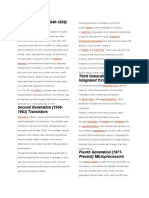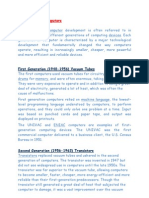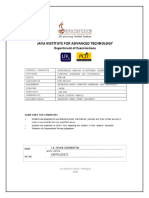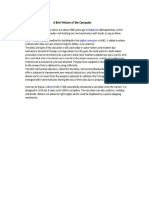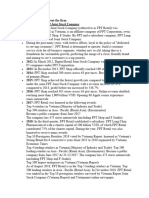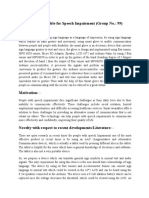Intro To Computing
Uploaded by
Antonio, Jachin Nicolai F.Intro To Computing
Uploaded by
Antonio, Jachin Nicolai F.Jachin Nicolai F.
Antonio
BSIT -1B
1.Generations of Computers
FIRST GENERATION: VACUUM TUBES (1940–
1956)
The first computer systems used vacuum tubes for circuitry and magnetic drums for main memory, and they
were often enormous, taking up entire rooms. These computers were very expensive to operate, and in addition
to using a great deal of electricity, the first computers generated a lot of heat, which was often the cause of
malfunctions. The maximum internal storage capacity was 20,000 characters.
First-generation computers relied on machine language, the lowest-level programming language understood by
computers, to perform operations, and they could only solve one problem at a time. It would take operators
days or even weeks to set up a new problem. Input was based on punched cards and paper tape, and output was
displayed on printouts.
It was in this generation that the Von Neumann architecture was introduced, which displays the design
architecture of an electronic digital computer. Later, the UNIVAC and ENIAC computers, invented by J.
Presper Eckert, became examples of first-generation computer technology. The UNIVAC was the first
commercial computer delivered to a business client, the U.S. Census Bureau in 1951.
SECOND GENERATION: TRANSISTORS (1956–
1963)
The world would see transistors replace vacuum tubes in the second generation of computers. The transistor
was invented at Bell Labs in 1947 but did not see widespread use in computers until the late 1950s. This
generation of computers also included hardware advances like magnetic core memory, magnetic tape, and the
magnetic disk.
The transistor was far superior to the vacuum tube, allowing computers to become smaller, faster, cheaper,
more energy-efficient, and more reliable than their first-generation predecessors. Though the transistor still
generated a great deal of heat that subjected the computer to damage, it was a vast improvement over the
vacuum tube. A second-generation computer still relied on punched cards for input and printouts for output.
THIRD GENERATION: INTEGRATED
CIRCUITS (1964–1971)
The development of the integrated circuit was the hallmark of the third generation of computers. Transistors
were miniaturized and placed on silicon chips, called semiconductors, which drastically increased the speed
and efficiency of computers.
Instead of punched cards and printouts, users would interact with a third-generation computer
through keyboards, monitors, and interfaces with an operating system, which allowed the device to run many
different applications at one time with a central program that monitored the memory. Computers, for the first
time, became accessible to a mass audience because they were smaller and cheaper than their predecessors.
FOURTH GENERATION: MICROPROCESSORS
(1971–PRESENT)
The microprocessor ushered in the fourth generation of computers, as thousands of integrated circuits were
built onto a single silicon chip. The technology in the first generation that filled an entire room could now fit in
the palm of the hand. The Intel 4004 chip, developed in 1971, integrated all the components of the computer,
from the central processing unit and memory to input/output controls, on a single chip.
In 1981, IBM introduced its first personal computer for the home user, and in 1984 Apple introduced the
Macintosh. Microprocessors also moved out of the realm of desktop computers and into many areas of life as
more and more everyday products began to use the microprocessor chip.
As these small computers became more powerful, they could be linked together to form networks, which
eventually led to the development of the Internet. Each fourth-generation computer also saw the computer
development of GUIs, the mouse, and handheld technology.
FIFTH GENERATION: ARTIFICIAL
INTELLIGENCE (PRESENT AND BEYOND)
Fifth-generation computer technology, based on artificial intelligence, is still in development, though there are
some applications, such as voice recognition, that are being used today. The use of parallel processing and
superconductors is helping to make artificial intelligence a reality. This is also so far the prime generation for
packing a large amount of storage into a compact and portable device.
Quantum computation and molecular and nanotechnology will radically change the face of computers in years
to come. The goal of fifth-generation computing is to develop devices that will respond to natural
language input and are capable of learning and self-organization.
Source: https://www.webopedia.com/insights/generations-of-computers/
2.Different Types of Computers
Mainframe Computer
It is high capacity and costly computer. It is largely used by big organizations where many
people can use it simultaneously.
Supercomputer
This category of computer is the fastest and also very expensive. A typical supercomputer can
solve up to ten trillion individual calculations per second.
Workstation Computer
The computer of this category is a high-end and expensive one. It is exclusively made for
complex work purpose.
Personal Computer (PC)
It is a low-capacity computer developed for single users.
Apple Macintosh (Mac)
It is a sort of personal computer manufactured by Apple company.
Laptop computer (notebook)
It is a handy computer that can be easily carried anywhere.
Tablet and Smartphone
Modern technology has advanced further. It has helped develop computers that are pocket
friendly. Tablets and smartphones are the best examples of such computer.
Source: https://www.tutorialspoint.com/basics_of_computer_science/basics_of_computer_science_types.htm
2.a. What is the most common type of a computer?
- Based on my observation the most common type of a computer is of course the Tablets and
Smartphones. On this day even kids have it because its affordable and easy to carry.
2.b. What are the types of microcomputers?
Desktop Computer.
Laptop.
Smartphone.
Notebook.
Tablet.
You might also like
- Computer Generations: First Generation (1940-1956) Vacuum TubesNo ratings yetComputer Generations: First Generation (1940-1956) Vacuum Tubes2 pages
- Generation of ComputerssSssSSSsSSSSSSSSSsNo ratings yetGeneration of ComputerssSssSSSsSSSSSSSSSs2 pages
- Bahaudin Zakriya University Multan.: Assignment On Generations of ComputerNo ratings yetBahaudin Zakriya University Multan.: Assignment On Generations of Computer5 pages
- The Five Generations of Computers: First Generation (1940-1956) Vacuum TubesNo ratings yetThe Five Generations of Computers: First Generation (1940-1956) Vacuum Tubes2 pages
- Generation of Computer First Generation: Vacuum Tubes (1940-1956)No ratings yetGeneration of Computer First Generation: Vacuum Tubes (1940-1956)4 pages
- Computer Generations: Types of Computer Generation and ExamplesNo ratings yetComputer Generations: Types of Computer Generation and Examples5 pages
- History of Computer Generations: First Generation (1940-1956) Vacuum TubesNo ratings yetHistory of Computer Generations: First Generation (1940-1956) Vacuum Tubes2 pages
- First Generation (1940-1956) Vacuum Tubes: Univac EniacNo ratings yetFirst Generation (1940-1956) Vacuum Tubes: Univac Eniac1 page
- First Generation: Vacuum Tubes (1940-1956) : Magnetic Drums MemoryNo ratings yetFirst Generation: Vacuum Tubes (1940-1956) : Magnetic Drums Memory5 pages
- Computer Generations: 1940 - 1956: First Generation - Vacuum TubesNo ratings yetComputer Generations: 1940 - 1956: First Generation - Vacuum Tubes3 pages
- Five Generations of Computers: by Hashir MubeenNo ratings yetFive Generations of Computers: by Hashir Mubeen8 pages
- Part 02 - Lesson 1 Introduction To ComputerNo ratings yetPart 02 - Lesson 1 Introduction To Computer7 pages
- Lecture-7-Generations of Computer: Dr. Asif RaheemNo ratings yetLecture-7-Generations of Computer: Dr. Asif Raheem22 pages
- Assignment of Computer: Submitted To: Mam Ramash Zahra Submitted By: Sameen Roll No: 20 Class: Bs Physics 1 SemesterNo ratings yetAssignment of Computer: Submitted To: Mam Ramash Zahra Submitted By: Sameen Roll No: 20 Class: Bs Physics 1 Semester4 pages
- Holobuilder Construction Progress ManagementNo ratings yetHolobuilder Construction Progress Management11 pages
- TV'S Digital Makeover: Spruced Up, Teched OutNo ratings yetTV'S Digital Makeover: Spruced Up, Teched Out57 pages
- Smart Wearable For Speech Impairment (Group No.: 99) AbstractNo ratings yetSmart Wearable For Speech Impairment (Group No.: 99) Abstract5 pages
- Permanent Address (House No./Street/Barangay/City/Municipality/Province/Country)No ratings yetPermanent Address (House No./Street/Barangay/City/Municipality/Province/Country)4 pages
- ADLINK Technical Forum Ideal SFF Technical N Strategic-240215No ratings yetADLINK Technical Forum Ideal SFF Technical N Strategic-2402157 pages
- Future News: Can Parliament Seize The Opportunity To Better Communicate Parliamentary Democracy in A Digital World?No ratings yetFuture News: Can Parliament Seize The Opportunity To Better Communicate Parliamentary Democracy in A Digital World?62 pages
- BARTEC PIXAVI Gravity X Intrinsically Safe CameraNo ratings yetBARTEC PIXAVI Gravity X Intrinsically Safe Camera3 pages
- Can I Use A Reliance Jio 4G Sim in A 3G PNo ratings yetCan I Use A Reliance Jio 4G Sim in A 3G P16 pages












